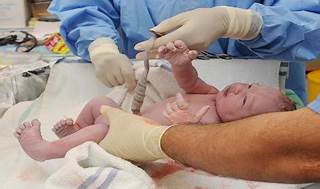A nurse is assisting with the care of a client who is in the first stage of labor. The nurse observes the umbilical cord protruding from the vagina. Which of the following actions should the nurse take first?
Prepare the client for an emergency cesarean birth.
Explain to the client what is happening.
Cover the cord with a sterile, moist saline dressing.
Place the client in a knee-chest or Trendelenburg position.
The Correct Answer is D

The correct answer is choice d. Place the client in a knee-chest or Trendelenburg position.
Choice A rationale:
Preparing the client for an emergency cesarean birth is important, but it is not the immediate first action. The priority is to relieve pressure on the umbilical cord to prevent fetal hypoxia.
Choice B rationale:
Explaining to the client what is happening is important for communication and reassurance, but it is not the immediate first action. Immediate physical intervention is required to prevent harm to the fetus.
Choice C rationale:
Covering the cord with a sterile, moist saline dressing is a necessary step to prevent the cord from drying out and to reduce infection risk, but it should be done after repositioning the client to relieve pressure on the cord.
Choice D rationale:
Placing the client in a knee-chest or Trendelenburg position helps to relieve pressure on the umbilical cord, which is crucial to maintain fetal oxygenation. This is the immediate first action to take in this emergency situation.
Nursing Test Bank
Naxlex Comprehensive Predictor Exams
Related Questions
Correct Answer is D
Explanation
Choice A rationale:
Helping the client to the bathroom to empty her bladder is not the appropriate response in this situation. The client's sudden urge to push indicates that she is in the second stage of labor, which is the pushing phase. The cervix is already dilated at 7 cm, and the fetus is at 1+ station, indicating that delivery is imminent. Emptying the bladder at this point is not a priority and may delay necessary actions.
Choice B rationale:
Assisting the client into a comfortable position is also not the appropriate response. The client's urge to push suggests that she is in the active stage of labor, and her cervix is already 7 cm dilated. Encouraging a comfortable position might not be suitable since the focus should be on monitoring the progress of labor and preparing for delivery.
Choice C rationale:
Having the client pant during the next few contractions is not the correct response either. Panting is typically recommended during the transition phase of labor to prevent rapid pushing and potential damage to the perineum. However, in this scenario, the client is already fully dilated, and the fetus is at 1+ station, indicating that the second stage of labor has commenced. Panting is not necessary at this point.
Choice D rationale:
The appropriate nursing response is to assess the perineum for signs of crowning. The sudden urge to push indicates that the baby is descending through the birth canal and may be close to crowning, which is when the baby's head becomes visible at the vaginal opening. By assessing for crowning, the nurse can determine if delivery is imminent and notify the healthcare provider for further actions and preparation for the baby's birth.
Correct Answer is D
Explanation
Choice A rationale:
Vaginal hematoma is not the most significant risk in the 4th stage of labor. While vaginal hematomas can occur due to trauma during delivery, they are less common and usually manageable compared to other complications.
Choice B rationale:
Hypoglycemia is not a typical complication in the 4th stage of labor. This stage refers to the immediate postpartum period, during which the mother's blood sugar levels may decrease slightly, but it is not the greatest concern at this stage.
Choice C rationale:
Chorioamnionitis is an infection of the fetal membranes and amniotic fluid. While it can be a concern during labor, the question specifically refers to the 4th stage, which occurs after the delivery of the placenta. Chorioamnionitis is more relevant to earlier stages of labor.
Choice D rationale:
Uterine hemorrhage is the greatest risk during the 4th stage of labor. This stage, also known as the "placental stage,”. is when the uterus contracts to expel the placenta. If the uterus fails to contract adequately, it can lead to significant bleeding, known as postpartum hemorrhage. This is a critical concern that requires immediate attention to prevent complications.
Choice E rationale:
Dehiscence, which refers to the reopening of a surgical wound, is not a common complication during the 4th stage of labor. The 4th stage primarily focuses on uterine contraction and placental delivery, making dehiscence less relevant in this context.
Whether you are a student looking to ace your exams or a practicing nurse seeking to enhance your expertise , our nursing education contents will empower you with the confidence and competence to make a difference in the lives of patients and become a respected leader in the healthcare field.
Visit Naxlex, invest in your future and unlock endless possibilities with our unparalleled nursing education contents today
Report Wrong Answer on the Current Question
Do you disagree with the answer? If yes, what is your expected answer? Explain.
Kindly be descriptive with the issue you are facing.
